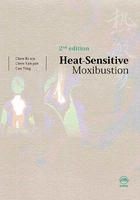
2 What Is Heat Sensitization of Acupoints?
Acupoints can be either tranquilized or sensitized. There are many different types of sensitization, and heat sensitization is one of them. Heat sensitization can be further divided into penetrating heat,expanding heat, transmitting heat, distal but not local heat, deep but not superf icial heat, and non-heat sensations.
During the past two decades of using moxibustion in the clinic, we have found that acupoints can be heat sensitized when people are diseased or not fully healthy. When suspended moxibustion is administered on these points, strange physical phenomena occur. Usually the one or more of the following six phenomena are seen.
The first, penetrating heat, is when the heat from the burning moxa stimulating the skin travels into the underlying tissues or organs. The second, expanding heat, refers to when the heat sensation moves outward from the spot receiving moxibustion. The third,transmitting heat, is when the heat sensation moves from the spot receiving moxibustion along a certain route, sometimes to the diseased area. The fourth, distal but not local heat,is when heat is felt at a site distal from the spot receiving moxibustion, but only a mild sensation is felt at the area receiving moxibustion. The fifth, deep but not superficial heat, is when heat is felt in the underlying tissues or organs but not at the spot receiving moxibustion. The sixth, non-heat sensations, are sensations other than heat that are felt at or away from the spot receiving moxibustion, such as soreness, distention, pressure,heaviness, pain, numbness and cold.
In this process, symptoms are relieved wherever the heat sensations reach. For example, when suspended moxibustion is administered on BL 12 (fēng mén), chronic shoulder pain can be relieved immediately if sensations of heat and distention travel to the shoulder. If suspended moxibustion is administered on GB 34 (yáng líng quán), chronic fatigue, heaviness, tightness and pain of the lumbar region can be eased if heat and distention reach the low back. If suspended moxibustion is administered on SP 6 (sān yīn jiāo) and the heat flows to the lower abdomen, pelvic hydrops can be greatly reduced over the course of several treatments. And if suspended moxibustion is administered on ST 25(tiān shū) and heat flows to the abdominal cavity, intestinal disorders can be significantly improved after several treatments.
A big reaction triggered by small stimulation is seen in all these examples, which means the acupoints in these patients must have been particularly sensitive to the moxa heat (on acupoints unrelated to the disease, moxibustion would only elicit local surface heat). This phenomenon is called the “sensitization of acupoints” and these points are called “heat-sensitized acupoints.” The sensitization of acupoints indicates there is also a desensitized or tranquilized state. There are many types of sensitization, of which heat sensitization is one. The reactions of heat-sensitized acupoints to the heat of moxibustion include penetrating heat, expanding heat, transmitting heat, distal but not local heat, deep but not superficial heat, and non-heat sensations. (Fig. 1-1) (Fullcolor images can be found at the end of the book.)




